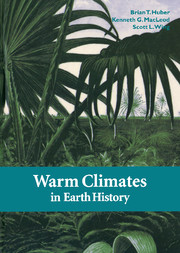Book contents
- Frontmatter
- Contents
- List of contributors
- Preface
- Part 1 Approaches to the study of paleoclimates
- 1 Warm climate forcing mechanisms
- 2 Recent advances in paleoclimate modeling: toward better simulations of warm paleoclimates
- 3 Comparison of zonal temperature profiles for past warm time periods
- Part II Case studies: latest Paleocene–early Eocene
- Part III Case studies: Mesozoic
- Part IV Case studies: Paleozoic
- Part V Overview: climate across tectonic timescales
- Index
- Plate section
1 - Warm climate forcing mechanisms
from Part 1 - Approaches to the study of paleoclimates
Published online by Cambridge University Press: 06 July 2010
- Frontmatter
- Contents
- List of contributors
- Preface
- Part 1 Approaches to the study of paleoclimates
- 1 Warm climate forcing mechanisms
- 2 Recent advances in paleoclimate modeling: toward better simulations of warm paleoclimates
- 3 Comparison of zonal temperature profiles for past warm time periods
- Part II Case studies: latest Paleocene–early Eocene
- Part III Case studies: Mesozoic
- Part IV Case studies: Paleozoic
- Part V Overview: climate across tectonic timescales
- Index
- Plate section
Summary
ABSTRACT
Warm climates present a particularly challenging test of our understanding of climate system processes. This paper reviews the possible mechanisms that can affect climate on long timescales. Increased radiatively active gases can act to warm climate but cannot by themselves simulate correctly the temperature gradient between equator and pole. Ocean and atmospheric heat transport, large bodies of water, a modified cryosphere, clouds, and surface vegetation are all thought to be of importance, but our limited ability to model some of these processes means that at present we cannot fully explain the mechanisms behind warm periods in earth history.
INTRODUCTION
Warm climates in the distant past provide one of the most challenging tests of our understanding of climate system processes and our ability to predict them. The differences between these climates and our present one are dramatic. It is hard to imagine a world in which, for instance, there were no ice caps at either pole. Why were these periods so warm? What processes could lead to a climate regime that was so radically different from our present one? What are the parallels with possible warmer worlds that are predicted for the future? These questions provide the motivation for paleoclimate studies of these periods, and elucidating them is of fundamental importance for our understanding of climate dynamics in warmer climate regimes.
- Type
- Chapter
- Information
- Warm Climates in Earth History , pp. 3 - 20Publisher: Cambridge University PressPrint publication year: 1999
- 3
- Cited by



